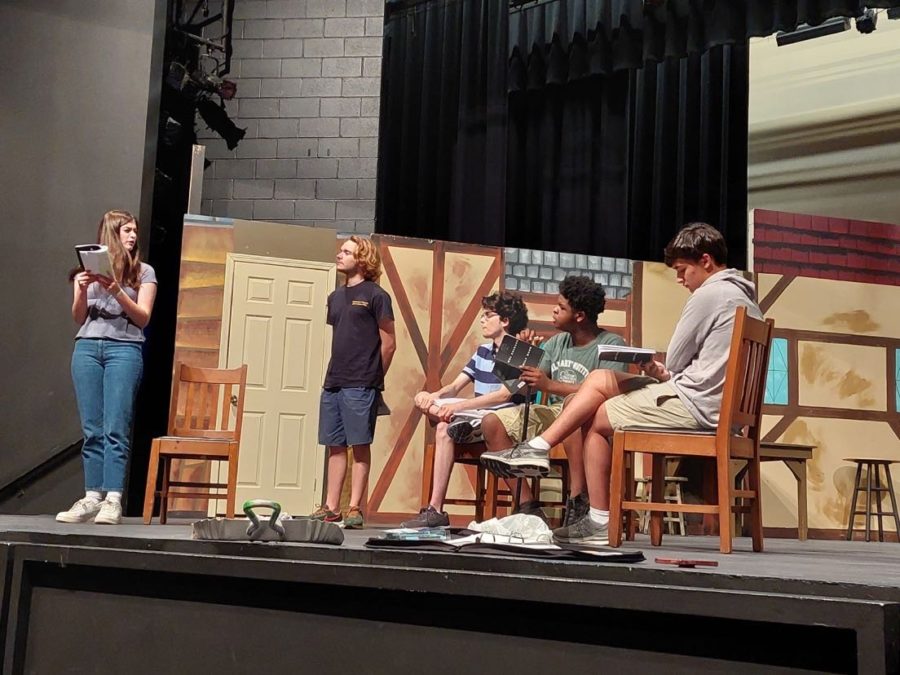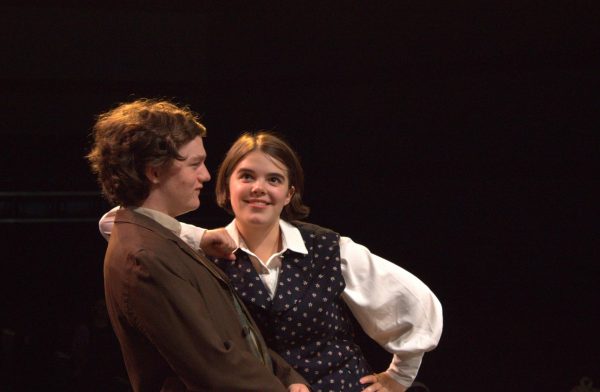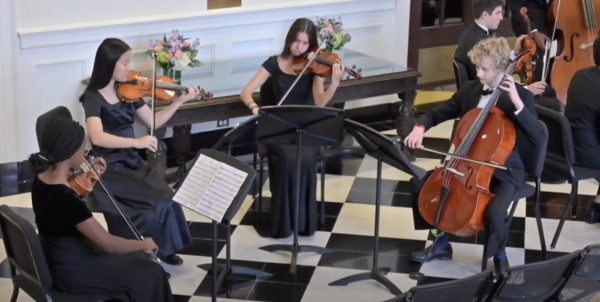Mrs. Packard: A Play Like No Other
Photo credit Emma Snyder
The cast of Upper School’s most recent play, “Mrs. Packard” rehearse for the scene in which Mrs. Packard (Annalise Jones ‘23, far left) pleads her sanity to Doctor McFarland (Reese Norman ‘23, center), and the trustees.
Illinois in 1861 was not a pretty time to be Elizabeth Packard, a wrongly institutionalized woman who was sent to an insane asylum by her husband for her differing religious beliefs. Based on this true story, Mrs. Packard explores what Elizabeth Packard endured, including heavy abuse, sexual assault, and suicide.
Starting the year off strong, the cast of Mrs. Packard has worked tirelessly to put together an incredibly relevant – yet unusually heavy – production.
It’s because of these themes that it’s been difficult, maybe more so than usual, to put the play together.
“I think there’s a thin line in rehearsal with keeping it serious enough to acknowledge all the harsh themes that come with the play but also keeping it fun and bonding as a cast,” said senior Annalise Jones, who’s playing Mrs. Packard. “So it’s been pretty tough trying to keep it serious enough to really understand it.”
Coupled with the seriousness of the play, there’s another major challenge that the Stage Cats have had to face: time crunch.
“The first play slot of the year always comes quickly – this one is extra fast. From the time we announced casting until performance, we’ve had about four weeks of rehearsal time,” said Stacy Chalmers, the director of this production.
And in the face of a deep, multifaceted performance like this, four weeks is barely any time.
But by just looking at the underlying, steady theme of women’s rights and the ongoing struggle for them dispersed throughout the performance, it becomes crystal clear that this show is being put on at just the right moment. The relevance of the play now, in this day and age, is undeniable.
“I feel like it’s still important today to understand the struggle for women’s rights in the U.S., even today with Roe v. Wade being overturned and all the struggles that come with that,” added Jones.
Building upon that, Chalmers said, “I felt like it was really the right time to do Mrs. Packard. I think women’s issues are super prominent in society, at this moment, and I believe that Elizabeth Packard, being one of the matriarchs of women’s liberation, is a person that we should hold up as an example right now.”
And yet, despite all of these heavy messages and daunting challenges, the behind-the-scenes work has marched on, from coordinating to costuming. While the process of gathering props, costumes, and set pieces (including the odd twin mattress or two) has been relatively standard, there’s been a whole new piece added to the production side. For the first time at Westminster, the help of both a combat and an intimacy choreographer has been enlisted.
“We’ve worked with a great fight choreographer, Marcus Durham, who works in the industry, here in Atlanta. He does a lot of work for film and television, and a lot of work with professional theater in Atlanta. He came in and choreographed those bits [combat scenes] for us, and so part of our everyday rehearsal is a fight call where the actors who are involved with that scene rehearse that material, even if we’re not doing that scene that day, so that they can develop some muscle memory on it; so they can be safe,” said Chalmers as he broke down the job of the combat coordinator.
Working on combat has also been a fun, bonding experience for the castmates involved.
“I think the most fun part [of rehearsals] is definitely learning new things. Like, there’s so much technicality for combat and how to coordinate it and learning how to put on combat and make it look realistic while keeping it safe has been interesting,” Jones said.
Not only does the combat look impressive on stage, but it also helps to tie everything together, unifying and polishing the preexisting pieces.
“We’ve actually gotten to work with a fight coordinator and he is teaching us some stage combat, so that was a really cool experience to get to learn some moves and stuff and just to pull it all together,” said freshman Maya Harper, who’s worked with Durham.
As for the intimacy choreographer, their job is slightly more complicated, but just as important. In a play with more mature themes reflected in the script, there are heavier, darker scenes, with the potential for making the actors uncomfortable. That’s where the intimacy choreography comes in.
“They [the coordinator] give them the language, they give them agency, they give them the permission to do that [take a break from the scene],” said Chalmers. “The other thing, as a choreographer, that they do, is they actually, physically block those [uncomfortable] portions, using the actor. […] So the choreographer works to say, ‘okay, what if we did this instead, that would convey the same intention, without having the same physical action associated with it?’ And that way, at the end of that process, the actors have a scene where they both know exactly what to do, and they both feel comfortable with their actions. And they feel like they have control if they need to say, ‘stop, we need to do something different here. We need to change this.’”
With all of these additions and supplements to an already outstanding production, Mrs. Packard is sure to be play perfection. Mrs. Packard was performed on September 23-24.
Edited by Evvie Morgan






